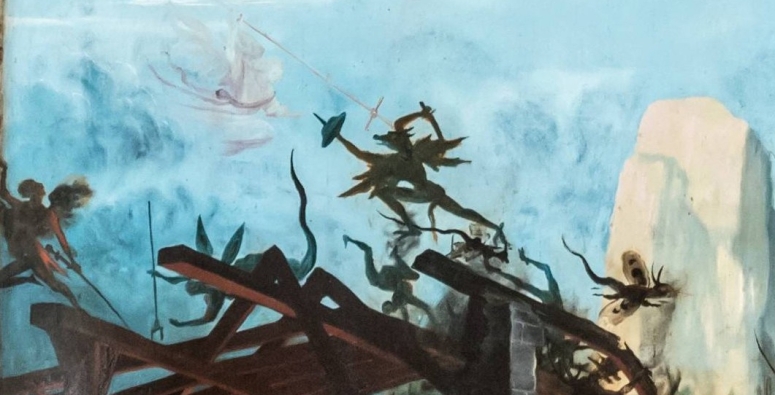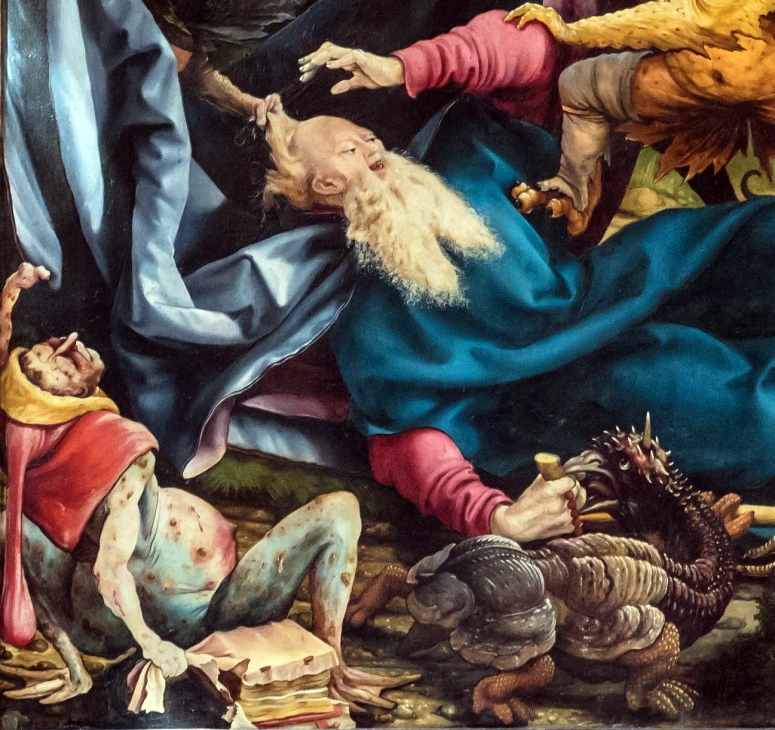Matthias Grünewald and the Isenheim Altarpiece
Most paintings by the German Late Gothic–Renaissance master Matthias (or Mathis) Grünewald (ca. 1470 – 1528) lay in the bottom of the Baltic Sea, sunk on their way to Sweden as war booty. Only ten of them —but several consisting of many panels– survive.
Among these remaining treasures, the most important, by far, is the Isenheim Altarpiece, created between ca. 1512 to 1515/1516, which consists of nine large panels, arranged on double wings to present three views (rather than just the open and closed states of triptych altarpieces), according to the season or occasion. Three of these panels are dedicated to Saint Anthony Abbot and two of them conform the third possible display:
[This is a large image (4698 x 4044 pixels), worthy to be seen in detail! (You may do it by clicking on it)]
[Musée d’Unterlinden, Colmar, Alsace, France]
.
The right wing on this display represents the meeting of Saint Anthony with Saint Paul of Thebes –a hermit himself, older than Anthony–, as narrated in “Vita Sancti Pauli”, written by St. Jerome in the years 375-377. The account of the relationship between the two saints (with the episode of the crow who brings them bread, so that they can be fed) until the burial of the very old Paul by Antonio, was taken up in medieval accounts of the lives of the saints, first place in the famous “Legenda Aurea” by Jacopo da Varagine, which is the direct source of the painters. This panel recalls the sacrifice of the abandonment, on the part of the holy men, of the pleasures of the world. Anyway, the lanscape figured by the painter is dreamlike and even stunning; a fantastic place with some strange mixture of vegetation and medicinal plants growing at the feet of the figures.
The left wing shows Anthony fiercely attacked by demons, as told by Athanasius of Alexandria. This is not in rigour one of the episodes of temptation our poor Saint suffered (also according to Athanasius), but the direct participation of hellish creatures in it makes it congruent and directly relevant to the subject of this series. Grünewald painted Anthony trampled to the ground, beaten with sticks, torn by claws and bitten; he appeals to God for help who sends angels to combat the demons.
Each panel measures 265 cm. (at the highest side) x 139 cm. and is painted with oil and tempera on linden wood – with extraordinary detail as I will show better in the partial views below. The colours, after a convenient cleaning and restoration, seen in a proper light, look impressively sprightly in several parts, and very modern too for a work painted more than 500 years ago.
Also, in contrast with most (if not all) of the paintings about this theme during the first half of 16th century, and even later, Grünewald does neither copy nor follow the iconography made so popular by H. Bosch; Grünewald’s monsters are different, more in the line of those imagined by his fellow Alsatian artist Martin Schöngauer, and the extraordinary engraving by him “St. Antonius von Dämonen gepeinigt” (ca. 1470-75), which you may see in a precedent post of mine on this theme: The Many Temptations of St. Anthony the Great (II) – Martin Schöngauer and the very young Michelangelo Buonarroti).
.
.
The figure at the lower left corner, with an awfully distended belly and ulcerous growths, seems to personify advanced ergotism; a sickness that in the Middle Ages was known as “Saint Anthony’s fire” – named that way after monks of the Order of St. Anthony, who were particularly successful at treating this ailment. In fact, the altarpiece was painted for the Monastery of St. Anthony in Isenheim, which specialized in hospital work: the caring of plague sufferers. Thus, presented in that place, the altarpiece had a thaumaturgical function for all patients and all peregrins who came to pray, waiting for some miraculous help. (Even the central image of the crucified Christ in the first and main display of the altar –as you may watch below– is pitted with plague-type sores, showing patients that Jesus understood and shared their afflictions.) This most peculiar figure acted as a main link between the viewers and the scene; a sufferer of ergotism would identify with him and be aware that even the Saint underwent terrible torments, but his faith and prayers brought to him the heavenly help.
.
I feel really impressed by the elegant concision of the scene representing this fight. Such shadowy devils and half-spectral angel weaving a spear with a Tau-shaped cross at its extreme (the “tau” being the very symbol of St. Anthony), confronting amid the smoke from the ruins and ashes of the Saint’s home, seems very actual to me (somehow cartoon-like, and anyway it could belong in a 20th century, illustrated book of fantasy – just have a look at a closer and differently framed view:
.

.
To end this increasingly detailed little gallery about the panel of my interest, and to bring back some equilibrium or symmetry, I add a complete view of the altarpiece’s complete third display, showing the carved and gilded wood central altarpiece by Nikolaus Hagenauer, flanked by the St. Anthony’s panels set in the reverse position shown at the beginning of my post.
.
.
Now it is right time to attach the first, most seen and best known configuration of our altar, displaying The Crucifixion framed on the left by the martyrdom of Saint Sebastian pierced by arrows, and on the right, again by Saint Anthony the Great; standing up quite placidly, but, as usual, being taunted by a frightening devil… Both saints were believed to protect and heal the sick; Anthony as the patron saint of the victims of ergotism, while Sebastian was invoked to ward off the plague.
.
.
In the immediate post-WWI period the altarpiece, with its strong overtones of violence, emotion and mystery, became a source of inspiration for painters in the Expressionist school, such as George Grosz and Otto Dix. It also provided the basis for Paul Hindemith‘s 1934 symphony, and later, the opera “Mathis der Maler” (Mathis the Painter), referred to three of the paintings in the Isenheim Altarpiece; among them “Die Versuchung Hl. Antonius”.
P.S.: I believe I have to give a hug and apologize to my few actual readers for the length of this post, rather unusual (at least lately) on the blog. I also hope you do not flee forever…









Not to worry on the length, I found it fascinating and informative. Thank you 😊
LikeLiked by 2 people
Thank you so much, dear :)) 💝
All my fondness and warm warm hugs !
LikeLiked by 1 person
I always enjoy reading your very well informed blog posts about art. Your choices are excellent. I didn’t know Grünewald, and he does remind me of Bosch, not just in the subject matter, but also in the fantastic and supernatural depiction of the subject. Thanks, Li! Big hug 🍒🍃😘💚
LikeLiked by 1 person
You are a sweetheart, Elisabeth 🙂 Thank you so much for your interest and your kindness 💋 !!
As for Bosch, I have been stunned by his work since I was a teen and saw his works in Madrid (by the way, stolen with violence by the Spanish governor in Flandes, as Spaniards have always done and continue to do –now with Catalan Medieval artworks from our museums :(( )
My posts about Bosch masterpieces on St. Anthony, and additional paintings from his workshop, will follow one day… when I feel with the necessary time and energy to end them, since these are the longest and more difficult of them all. Bosch is so great, so singular, other-worldly and overwhelming that I will need quite a lot of time to dare to deal with him :))
BTW, do you know what did mean, in Bosch’s usual symbology, a couple of cherrys ? … (A hint: have a look at the central panel of “The Garden of Earthly Delights”) — A big tight hug, my friend 💛 💚 💙 💜 !
LikeLike
You’re very welcome, my dear Li! 😊 I wouldn’t say it if I didn’t mean it.
As for Bosch, yes, he is very unique. I remember first seeing his work when I was little with my father.
I didn’t get the cherries, but I looked up the central panel and found the girl with the cherries on her head, a symbol of pride apparently 😄
Big big hug back to you, my dear! 💚🍒🌈😘
LikeLiked by 1 person
A pair of cherries was one of the ways Bosch represented the masculine genitals and, so, the wish –or the act itself– of sexual intercourse.
(I do not have anything against it, of course! In fact, I am in very nice terms with cherries, but I think we, you and I, play in the same field regarding this. LOL) — KISSES!
LikeLiked by 1 person
Haha, oh, it doesn’t say that on Wikipedia 😄😉 Yes, I like cherries too 😄🍒
LikeLiked by 1 person
Oh, my Dear! I’m so amazed at the color and movement of this work – I can’t imagine how it would have appeared to people 500 yrs ago. Something very futuristic and extreme, to say the least! What a pity his other works went to the bottom of the sea. You find so many wonderful and interesting things!
*hugs and kissies*
LikeLiked by 2 people
You are very right, Liz; Grünewald looks “futuristic and extreme” (what a fine description!…)
As for works lost… since Europe has been always in war from prehistoric times, most books, paintings, buildings, etc., etc. have been destroyed. Once I read about a reasonable estimate of about 90% of them !!!!
I DO hope you are feeling a little better and less bothered by people and contingences around you !! (I seems winds blow right to our faces lately… since I am rather cracked and tired –despite I some decent income now and may afford a few things I had to renounce (eating well to begin with, but also buying some quality lube and a few new books :))
*All hugs and kissies and petting back to you*, my big Sis.
LikeLiked by 1 person
You Sweet!
Oh, my… 90% seems like such a huge number – and then you look at the time and the events and it seems miraculous that it’s not higher.
Holding on – and about to seek some relief. 😉
All the hugs, iced lattes and a lovely spring fed pool, my dear – where we can float or dunk toes as desired!
LikeLike